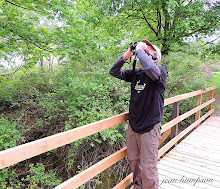We then stopped at the Mizzy Lake Trail parking lot with no plans to hike the trail. It's an 11 kilometre long trail and the information guide suggests 6 hours is required to complete the loop. We have hiked Mizzy Lake in the past but this day we would simply survey the trees surrounding the parking lot and end up seeing 3 Northern Flicker, Chipping Sparrow, Black-capped Chickadee and Yellow-rumped Warbler.
A quick visit to the Visitor Centre produced no new birds, in fact there was little activity at the feeders. After lunch at Costello Creek, we travelled further east to look for the woodpecker observed the day before. We would find the Black-backed Woodpecker but he was excavating on a utility pole 2 kilometres west of the pole he was at on Saturday.
We would turn around stopping at the Spruce Bog Boardwalk. We hiked in a light rain, observing only 1 Red-breasted Nuthatch before crossing Sunday Creek Bog.
Looking west from the Spruce Bog Boardwalk.
In the background is the Black Spruce forest where we observed our lifer Spruce Grouse.
On Sunday Creek we viewed a lone male Common Merganser before entering the Black Spruce forest east of the bog in search of the elusive Gray Jay. As previously mentioned, they are difficult to spot at this time of year. We walked along the boardwalk surrounded by Black Spruce and nearing the end of the bog where the trail becomes a dirt path, I spotted some movement. It was a bird and I thought it was possibly a Blue Jay. Jean and I remained still but I could not find the bird again. Shortly after that brief glimpse, a dark gray bird with a white collar and forehead flew towards Jean and I. This was the species we missed on Saturday. A Gray Jay, lifer #257. It was looking for some handouts but unfortunately we had none. We were able to get some great views of the Gray Jay as it moved from spruce to spruce.
Even if I was not dressed appropriately for the weather, I would have ignored the light rain that was falling. This was one cool bird! I found another use for my cycling rain coat. It's handy and can be easily rolled up when not needed. The only difference, it's considerably easier to put on and take off while birding than it is while cycling. After a few minutes the Gray Jay would disappear to tend to it's young, not to be seen again.

We returned to the Visitor Centre to enter our observation on the wildlife board in the lobby. A quick scan of the feeders again did not produce anything new. It was time to leave the park and head back to St. Catharines. Outside of the centre we had a short chat with the park naturalist Justin, who led last year's guided walk at the Old Airfield. Before exiting the park Jean and I would add one more species to the year list. 2 Broad-winged Hawks (#106) were soaring above Highway 60. The last animal we would see however was the moose seen the day before. Same spot, same time of day.
Spending the last weekend of April in Algonquin was very productive. A total of 4 lifers were observed, Boreal Chickadee was added to the provincial list, and a total of 16 species were added to the year list. 2009 is looking to be a good year. Observing all 4 Boreal species should assist in the quest to surpass the 187 species observed in Ontario last year. Warblers are next or should I say now.











No comments:
Post a Comment